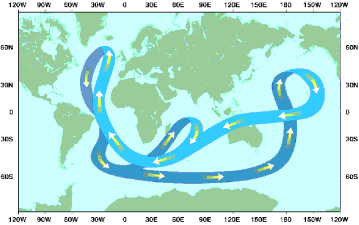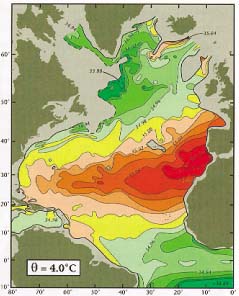It is quite evident from observations of ocean flow that the wind moves water, and that the wind is one of the primary forces that drive ocean currents. In the early part of the 20th century, a Norwegian scientist, Fridtjof Nanson, noted that icebergs in the North Atlantic moved to the right of the wind. His student, V. Walfrid Ekman, demonstrated that the earth's rotation caused this effect and in particular, that the Coriolis force was responsible and in the Southern Hemisphere, it causes water to move to the left of the wind. One of the primary results of Ekman dynamics is that the net movement of water, forced by large-scale winds, are to the right (left) of the wind in the Northern (Southern) Hemisphere. This is a surprising result since one would guess that water moves in the direction of the wind, and a quick glance at wind and current data would also indicate this. For example, the Gulf Stream flows eastward, in the direction of the overlying westerly winds (winds flowing from west to east). However, the story is more complicated than this.
Winds accelerate (near-)surface fluid particles by imparting momentum to the fluid through surface stresses. At first, particles move in the direction of the wind. As time goes on, the earth's rotation deflects the particles to the right/left in the Northern/Southern hemispheres, respectively. The large-scale mass field adjusts so that there is an approximate geostrophic balance between the pressure gradient force and the Coriolis acceleration.
 
|
Figure 1: (a) The westerly winds, that blow over most of the U.S., forces a net movement of water to the south, due to Ekman dynamics. The easterly winds, that blow over the (sub)tropical Atlantic, forces a net movement of water to the north, due to Ekman dynamics. There is a convergence of mass and a resulting high-pressure system, known as the subtropical gyre, is formed. The Coriolis acceleration sets up a clockwise gyre circulation around the high pressure. (b) The circulation of the Northwest Atlantic as deduced from hydrographic measurements by Worthington (1976). The flow is parallel to the streamlines and is in the clock-wise or anti-cyclonic direction. The speed is inversely proportional to the spacing between streamlines. e.g. the flow is fastest where the streamlines are closest together. (c) Gyre flow pattern, based on Stommel's original wind-driven ocean circulation theory, illustrating the western-intensification of ocean currents.The Coriolis force varies over the globe as a function of latitude, being zero at the equator, a minimum at the S. Pole and a maximum at the N. Pole. In the late 1940s, Henry Stommel showed that this variation of the Coriolis force was responsible for the observed fact that western boundary currents, such as the Gulf Stream and the Kuroishio, are much narrower and faster than eastern boundary currents, such as the California Current and Canary Current. Both of these western boundary currents move significant amounts of warm waters northward and are important in transporting the excess heat the earth receives in the tropics towards the poles. Oceanic gyres are not symmetric due to faster currents on their western boundaries (Fig. 1c).
Another way to get pressure differences in a fluid is through density differences in the fluid. The density of ocean water is primarily determined by its temperature, salinity, and the pressure of the surrounding water. Typical variations in salinity and temperature lead to density differences that are two to three orders-of-magnitude smaller than the wind-driven air-water density differences. When water is sufficiently cooled, at polar latitudes, by cold atmospheric air, it gets denser and sinks. The vertical sinking motion causes horizontal water motion as surface waters replace the sinking water. This is one example of what oceanographers call thermohaline flow. The large-scale flow pattern that results from the sinking of water in the Nordic and Greenlans Seas and around Antartica is called the oceanic conveyor belt (figure 2a). Another example of thermohaline flow occurs in the Mediterranean Sea in summer when water gets heavier due to strong evaporation that transports fresh water into the atmosphere, feeding the hydrological cycle, and leaves salts behind that make the water denser and it sinks. This salty water, produced in the Mediterranean Sea, can be found in the Atlantic Ocean at depths of 1000 to 1500 m (figure 2b).

Figure 2a

Figure 2b
Figure 2: (a) A cartoon of the global thermohaline circulation. Most of the poleward transport of warm waters occur along the western boundaries and the sinking of dense surface waters occur in relatively small regions. The upwelling of water occurs basin-wide and is most pronounced in regions with divergent Ekman transport. (b) The distribution of salinity on the four degree (Centigrade) potential temperature surface illustrates the Mediterranean salt tongue. High salinity water, formed by evaporation in the Mediterranean Sea, spills over the sill at Gibraltar, mixes with North Atlantic water, and spreads out thousand km across the basin.The other major driving mechanism for ocean flow are due to tides primarily generated by the moon and sun. In the study of of open ocean currents, this part of the flow is usually considered noise. In coastal areas, tidal flow is usually the dominant flow component, and its prediction is important for navigating shipping channels in and out of major ports.